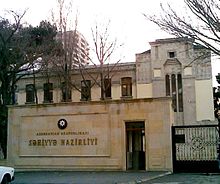Health care in Azerbaijan
The health care system in Azerbaijan consists of public and private health institutions and on the Ministry of Health regulated by Azerbaijan.
Historical introduction
Period of the Democratic Republic of Azerbaijan (ADR)
According to the decree of the Council of Ministers of the Azerbaijan Democratic Republic , the Ministry of Health was established on June 17, 1918. The surgeon Khuddat Rafibeyli was appointed first minister . Khudat Rafibeyli was a graduate of Kharkov University Medical School. To improve medical care, the government has developed a comprehensive plan to provide government-funded services to residents, to open new medical centers, and to build medical warehouses and laboratory buildings. In addition, necessary equipment was purchased on behalf of the ministry.
The government tried to improve the fight against epidemics and to upgrade medical services in regions with personnel and medicines. Over 30 hospitals were operating in the regions. Outpatient services were provided free of charge in villages. In rural areas, the main tasks of the existing hospitals and medical stations were hospitalization of infectious patients and the neutralization of disease areas. Taking into account the inadequacy of only one doctor for 75,000 residents, Parliament decided to open 35 new hospitals and allocate 56 medical assistance points and 45 billion manats to expand the hospital network in rural areas.
State pharmacies and an analytical laboratory have been set up in Baku to carry out medication and medical and legal examinations. A central warehouse was set up to ensure adequate and timely health care with medicines and medical supplies. Students were granted medical degrees abroad.
Soviet period
After the collapse of the ADR and the incorporation of Azerbaijan into the Soviet Union as the ASSR , the healthcare system developed as part of the Soviet healthcare system. The newly formed People's Commissariat of Azerbaijan benefited from the traditions that had emerged during the ARD period. The main task of the People's Commissariat was the fight against infectious diseases such as plague , chickenpox , malaria and measles .
Mohsun Gadirli was appointed health commissioner in November 1921 to implement reforms in the region. During his tenure, a unified health system was created that focused on personal training, improving medical services in rural areas, improving drug delivery to the population, and developing medical services for women and children.
Hospitals, outpatient clinics and other medical institutions have been established in the centers of different regions and larger residential areas. The implementation of the decrees on the nationalization of pharmacies, free distribution of food for children and free distribution of medicines for the population has also started.
The officially free public health care system suffers from funding bottlenecks, a lack of effectiveness and a backlog in the quality of medical services. In 2017, Azerbaijan was among the ten countries in the world with the lowest share of health expenditure. In 2018, public spending on healthcare was only around 1% of gross domestic product . The 2019 budget has $ 616 million available for healthcare. A major problem in the health sector is the shortage of medical professionals, particularly in general medicine. The costs to be borne by the public medical services are far too high in relation to the income of the population.
Private health care
The health expenditure of the population in the 2015 to 2017 decreased by a third compared to 2014. The decrease is also reflected in the number of visits to the doctor, for example 76.3 million visits were recorded in 2013 compared to 70.7 million visits in 2017. Of the number of visits in 2017, 70% were allocated to the private sector. A trend reversal is expected in 2020/21.
Azerbaijan has been running a pilot project for compulsory health insurance since 2007. To this end, the state invested 42 million US dollars in the city of Mingechevir and in the districts of Yvelach and Agdam by the end of 2018 . The investments are used to restructure medical facilities, for automated control systems, for the acquisition of medical technology and for better pay for staff. The health insurance contribution for employees subject to compulsory insurance should amount to 3% of the gross wage in the first phase. The employee should pay 2% and the employer 1%. The contribution for other employees should be 120 Azerbaijan manat (about 70 US dollars) annually.
Individual evidence
- ↑ a b History of Healthcare ( Azerbaijani )
- ↑ a b c d 90 yaşlı səhiyyəmiz .
- ↑ a b c Azerbaijan's healthcare system is changing | Data. Retrieved July 9, 2019 .
